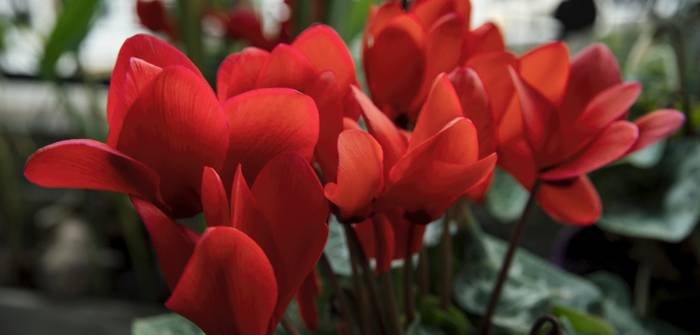“White as snow, red as blood, black as ebony” are the well-known lines from Snow White. Red has always had a mythical meaning. The color represents life. That’s what you bring with you intensive, red perennials into your garden. We show you a selection of beautiful, luminous representatives.
Red perennial plants: set highlights in the garden
Sweet nettle and hollyhock are two prominent representatives of the red perennial plants that thrive very well in sunny or partially shaded locations. They make a garden come alive and represent a bright contrast to plants with other colors. The sight of the red flowering perennial plants awakens the viewer’s joie de vivre. If the perennials in question have the ideal location, they reward the gardening efforts with an almost unbelievable joy of flowering, which begins in spring and lasts until late autumn.
Red perennial plants: We present 11 fiery representatives
1. Cyclamen (Cyclamen spec.)
Cyclamen are among the most popular flowers. The hardy, small perennials show their flowers from September until the first frost. Flower colors range from red and purple to white, as well as numerous variations on the main colors, and will bring life to a partially shaded location. Garden cyclamen need a calcareous location that is protected. If not contained, they multiply independently to form large areas.
2. Hollyhock (Alcea)
There are over 60 different types of hollyhocks. What they all have in common is that the perennial plants, also known as mallows, do not belong to the rose family, although their name suggests so. Hollyhocks bloom in a variety of colors from July to September. They show up with red or pink, violet to purple-black, and white or yellow flowers. The location is preferred in semi-shade or in the sun, whereby the soil can be poor in nutrients and sandy. Special garden soil is not necessary for hollyhocks.
3. Clove Root (Geum)
In this country, you can find different types of carnation roots. Garden avens in particular were able to spread. It blooms from April to August with red, pink, yellow, or white flowers. The insect-friendly perennial is easy to care for and very decorative. It needs a partially shaded location to thrive. There it can grow up to 80 cm high. The avens do well in a sandy and rocky site. Condition: The soil must be sufficiently moist. However, he does not like waterlogging.
4. Red angelica (Angelica gigas)
The large flowers of the red angelica are very impressive from June to August – sometimes a little later and then into September. In summer, the inflorescences grow from the tufts of green leaves, from which buds develop. Dark red umbels soon open up, a paradise for bumblebees and bees as well as other insects. The red perennial is biennial and can be stimulated to bloom for another year after pruning.
5. Bergenia (Bergenia)
The Bergenia likes moist, nutrient-rich soil that is well drained. It is advisable to use a sufficient layer of compost before planting. With care measures such as regular watering and pruning, the perennial will grow to tremendous proportions. It is considered one of the most attractive early bloomers and the gardener can admire its flowers as early as March. The Bergenia flowers until May in a strong pink to crimson. White bergenias are also known. As a perennial for the penumbra, the Bergenia is perfect if you want to beautify places in the garden that have received little attention.
6. Sweet nettle (Agastache rugosa)
From June to September, the scented nettle pleases the eye of the gardener. This is when the aromatic, fragrant flowers show their most beautiful side, glowing red, orange, or pink. The soil requirements for this perennial are low: it likes partial shade and dry, sandy soil. The flower spikes grow upright and in dense whorls, which is characteristic of all sweet nettles. They particularly like to stand together with evening primroses, goldenrods, or also primroses.
7. Spurflower (Centranthus ruber)
The red spurge is a perennial herb that likes partial shade but also likes to be in the sun. It flowers from June to September and is an ideal source of nectar for bees and insects due to the long flowering period. The spur flower is very undemanding and even grows in cracks in walls. The soil must not be acidic, it is less bad if it is low in nutrients. Spur flowers also survive dry periods well. The soil should not dry out completely. A little watering will therefore be necessary for summer.
8. Indian nettle (Monarda fistulosa)
The Indian nettle occurs as a hardy bee balm as well as in the original form as wild Indian nettle. Hybrids of both species are usually available on the market today, which means that the gardener is relatively free in the choice of location. Indian nettles thrive best in partial shade. They like dry, sandy soil. There, the perennial needs no further fertilizer. Flowering occurs between June and August. Indian nettles then bloom in a magnificent shade of red. They are ideal insects and bee perennials.
9. Sunbridge (Helenium Hybrid)
From June to September the red, yellow, or orange flowers of the sun bride appear, which can reach a height of up to 140 cm. The perennial is well hardy and only needs shelter when temperatures drop very well below freezing. It grows very upright in spring and later forms the characteristic corymbs. The sun bride likes fresh, nutrient-rich soil that can be a little loamy. The non-toxic plant is very popular with bees and insects.
10. Foxglove (Digitalis spec.)
The red foxglove is widespread throughout Central Europe. It grows up to 150 cm high. With its pretty flowers, it is very decorative and is mainly grown in partially shaded places. The pink-red flowers hang in a pretty raceme at the top of the stem and appear from June to August. The perennial is poisonous and thrives best in lime-poor, nitrogen-rich, and sandy soil. The red foxglove is very popular with insects and gets through the cold season well.
11. Carpet Aster (Aster ericoides)
The carpet aster flowers in a variety of colors and displays its red, pink, purple or blue flowers from August well into October. The perennial grows like a carpet and spreads quickly over the respective area. It only reaches a growth height of approx. 20 cm. Like all asters, the carpet aster is very undemanding and hardy. It simply drives out again in the next season. The soil should be dry to fresh and well drained to prevent waterlogging.
Frequently asked questions about perennials
How do insect-friendly perennials flower?
Insect-friendly perennials bloom with an open flower. As you can well imagine, a closed flower is inaccessible to insects of all kinds. Bumblebees, bees, and butterflies then have no access to the nectar. The perennials can also bloom in autumn when many of the flowers have already faded and the insects can hardly find any food.
What are low-maintenance perennials?
Easy-care perennials are particularly suitable for garden beginners. You only need a suitable location and are usually satisfied in partial shade. They do not make great demands on the soil, but they do not like waterlogging either. Good drainage is therefore important. Easy-care perennials only need a little pruning in the fall, but many don’t even need that. They need regular watering in the summer and otherwise bloom without any further effort.
How can butterflies be lured into the garden?
If you want to lure butterflies into the garden, you can offer artificial food in addition to colorful perennials. A cocktail of sugar (dextrose) and water or fruit juice attracts the butterflies. Ripe fruits also attract butterflies, so a pear tree in the garden, for example, is recommended. The butterflies will follow the sweet smell and stay if they find good conditions.








